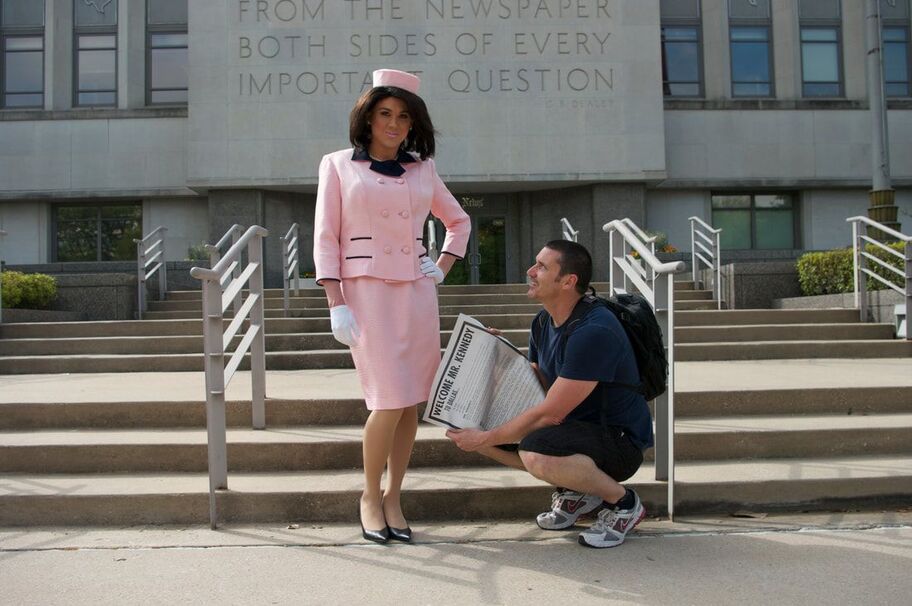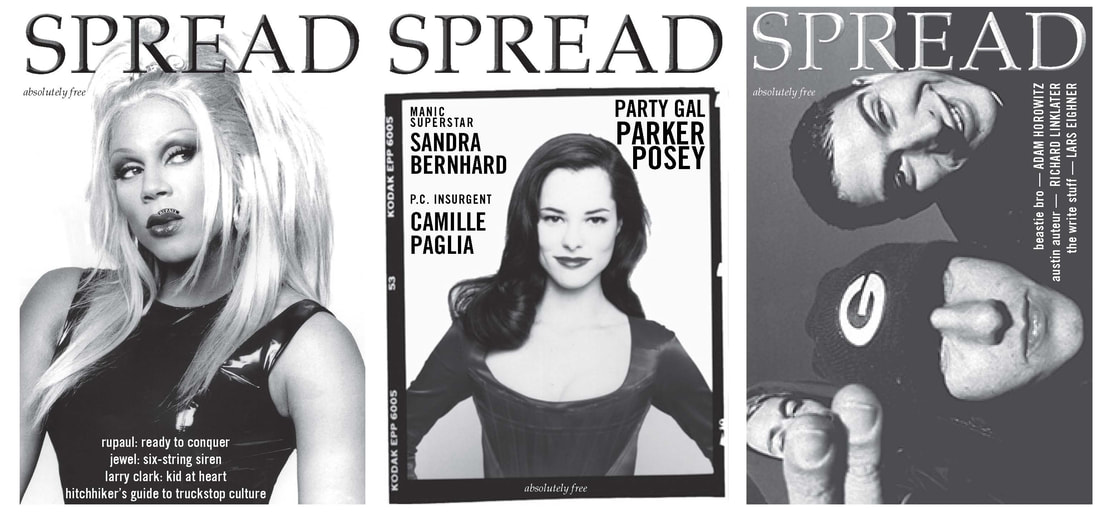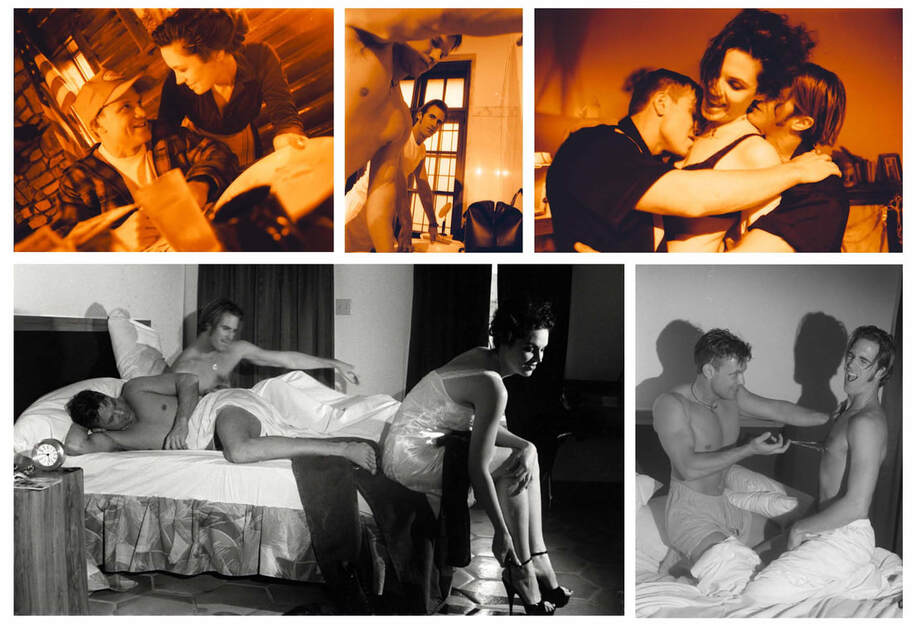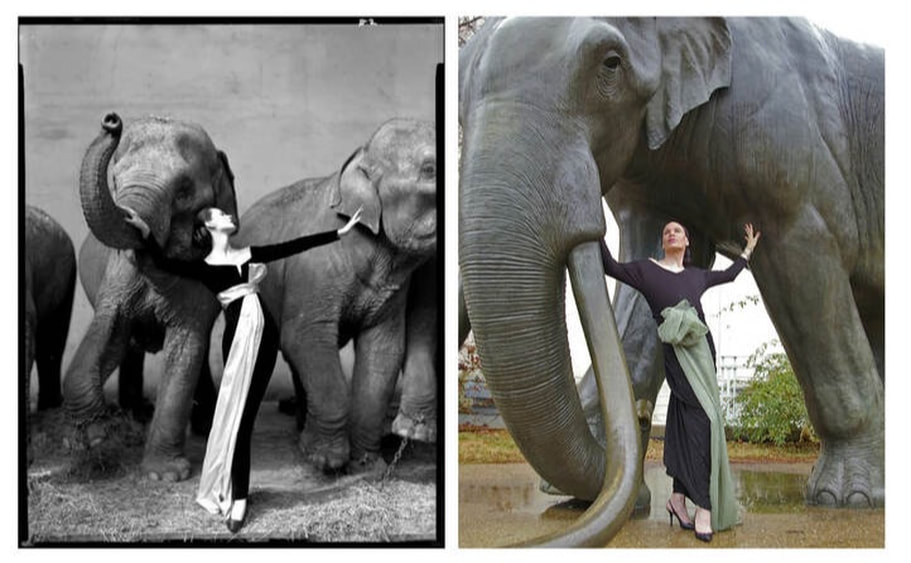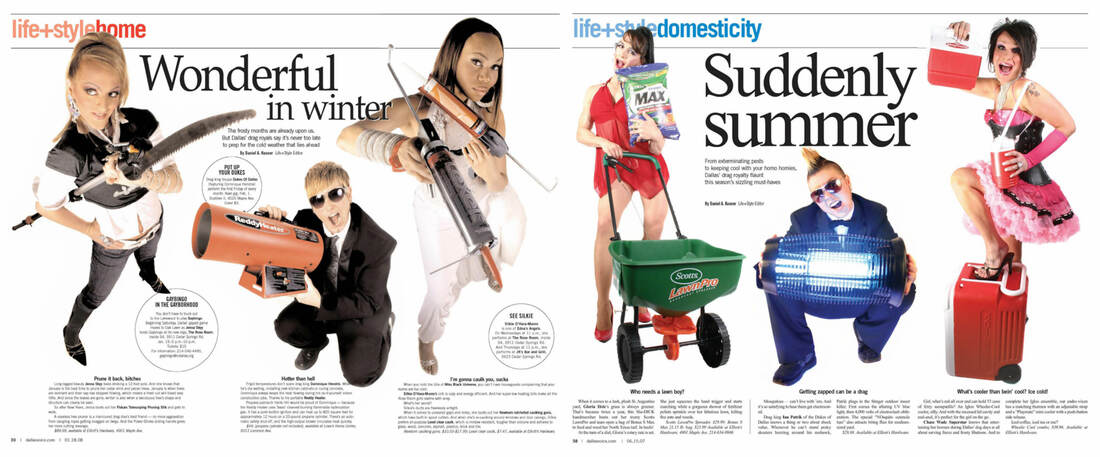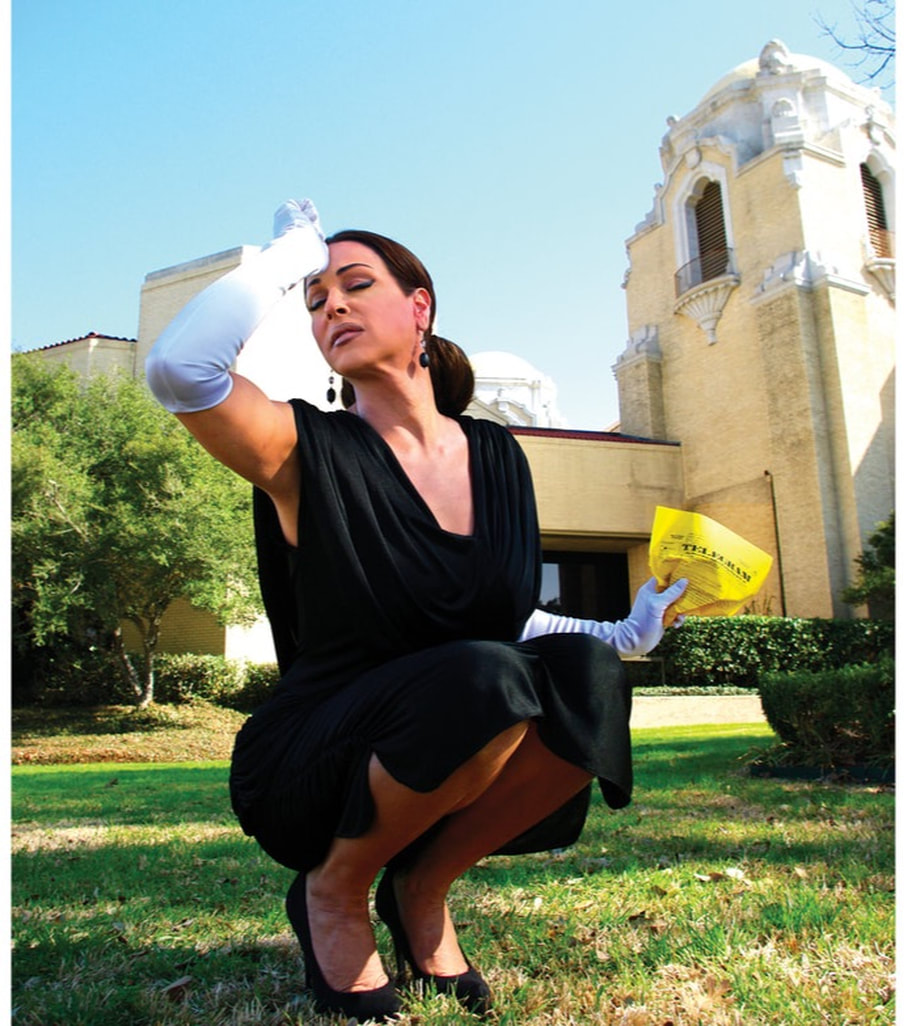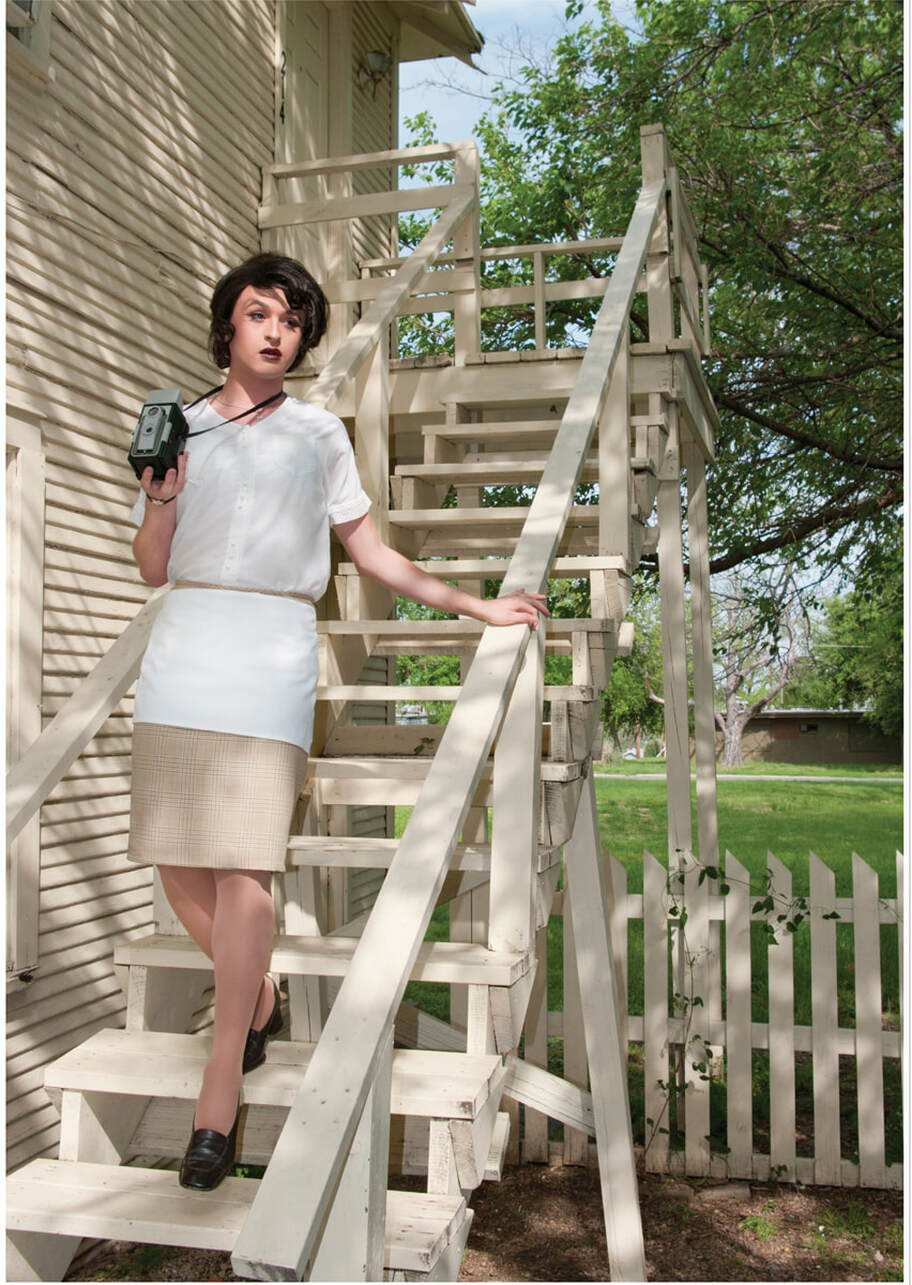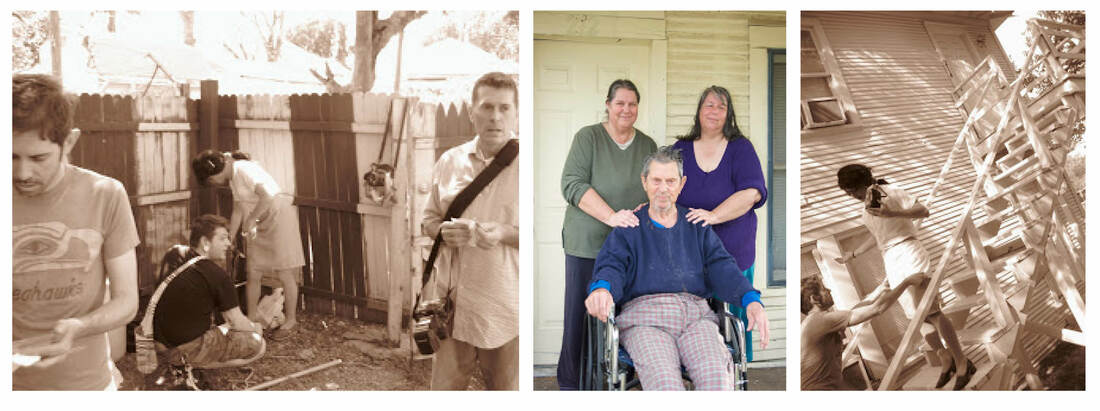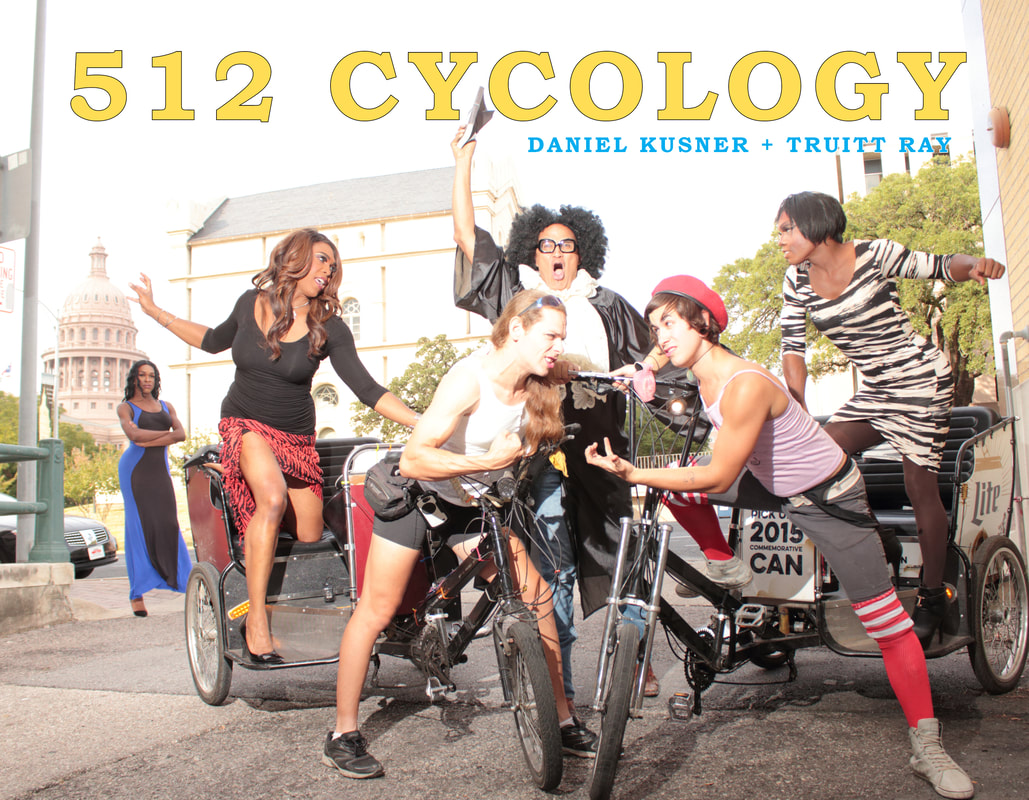ARTIST Q&A
The University of Texas at Dallas extends Daniel Kusner's transgender photography exhibit for 2013 summer
PLEASE EXPLAIN “214 TRANS4M."
A few years ago, I drove to Texas’ open-minded capital for a funky East Austin art opening.
Badass queer illustrations adorned the exhibition walls while gallerygoers downed freshly pumped keg-brew.
There, I was introduced to an Austinite — a darn-tootin' cowgirl, who wore embroidered boots and cat-eyed granny glasses.
Upon hearing that I'd just drove down from Big D, she narrowed her eyes and seethed, “Dallas? Eww...”
The Austin hipster's stink-face reaction was sidesplitting. Because Dallas stereotypes are — as they say — "two-hoots-and-a-holler" funny.
Apparently, Dallas attracts pretentious, gun-flashing Christians who worship pigskin and Hummers.
Our hairdos are supposedly teased so high-and-mighty, they can withstand 100-mile-per-hour gusts of wind.
"214 Trans4m” is a collaborative visual series that embraces Dallas architecture while illuminating remarkable women who’ve made their mark on North Texas.
Indelible figures, like, Mary Kay Ash, Tina Turner, Erykah Badu and Jan Crouch.
Badass queer illustrations adorned the exhibition walls while gallerygoers downed freshly pumped keg-brew.
There, I was introduced to an Austinite — a darn-tootin' cowgirl, who wore embroidered boots and cat-eyed granny glasses.
Upon hearing that I'd just drove down from Big D, she narrowed her eyes and seethed, “Dallas? Eww...”
The Austin hipster's stink-face reaction was sidesplitting. Because Dallas stereotypes are — as they say — "two-hoots-and-a-holler" funny.
Apparently, Dallas attracts pretentious, gun-flashing Christians who worship pigskin and Hummers.
Our hairdos are supposedly teased so high-and-mighty, they can withstand 100-mile-per-hour gusts of wind.
"214 Trans4m” is a collaborative visual series that embraces Dallas architecture while illuminating remarkable women who’ve made their mark on North Texas.
Indelible figures, like, Mary Kay Ash, Tina Turner, Erykah Badu and Jan Crouch.
These individuals are brought to life with transgender Texans.
I hope the approach draws a parallel between Dallas’ identity and gender identity.
The series is replete with historical research about Big D, which is an ever-evolving metroplex that frequently snubs architectural preservation while constantly building anew.
"214 Trans4m” reminds us that Dallas’ only consistent trait is transformation — not tradition.
It also informs George W. Bush’s neighbors that even before the City of Dallas was founded, half the population consisted of French-speaking settlers called Fourierists. They built a Texas society and called it “La Reunion.”
The Fourierists were following a dream. They envisioned Dallas as a promised land — one that abolished gender roles and defended homosexuality.
I hope the approach draws a parallel between Dallas’ identity and gender identity.
The series is replete with historical research about Big D, which is an ever-evolving metroplex that frequently snubs architectural preservation while constantly building anew.
"214 Trans4m” reminds us that Dallas’ only consistent trait is transformation — not tradition.
It also informs George W. Bush’s neighbors that even before the City of Dallas was founded, half the population consisted of French-speaking settlers called Fourierists. They built a Texas society and called it “La Reunion.”
The Fourierists were following a dream. They envisioned Dallas as a promised land — one that abolished gender roles and defended homosexuality.
WHERE'S “214TRANS4M" BEING EXHIBITED?
Right now, inside the Arcade Gallery at CentralTrak, which is The University of Texas at Dallas’ artists-in-residence program located in Expo Park, an adorable historic neighborhood nestled between Deep Ellum and Fair Park.
Throughout June, “214 Trans4m” was such a crowdpleaser, the exhibit landed the two-month summertime cover of Arts+Culture Texas magazine.
So CentralTrak extended its month-long run for a second month. The exhibit now closes July 31.
Throughout June, “214 Trans4m” was such a crowdpleaser, the exhibit landed the two-month summertime cover of Arts+Culture Texas magazine.
So CentralTrak extended its month-long run for a second month. The exhibit now closes July 31.
WHAT'S YOUR ART-AND-PHOTOGRAPHY BACKGROUND?
In the ’90s, I lived in Austin after graduating from UT. There, I published SPREAD, a large-format Warholian magazine.
I profiled the unusually famous — Roe. v Wade lawyer Sarah Weddington, homeless literary great Lars Eighner, necro-neoclassic photog Joel Peter-Witkin and gay-for-pay porn studs.
During the height of the ’zine celebrity-worship era, SPREAD also interviewed Parker Posey, Camille Paglia, Sandra Bernhard, Richard Linklater, The Beastie Boys, RuPaul, et al.
I profiled the unusually famous — Roe. v Wade lawyer Sarah Weddington, homeless literary great Lars Eighner, necro-neoclassic photog Joel Peter-Witkin and gay-for-pay porn studs.
During the height of the ’zine celebrity-worship era, SPREAD also interviewed Parker Posey, Camille Paglia, Sandra Bernhard, Richard Linklater, The Beastie Boys, RuPaul, et al.
For SPREAD, I designed Austin-area photoshoots with locations, like, the Dorsett 221 truck stop, Robert Mueller Airport, the Ritz Theater and UT’s marble bathrooms in the basement of Battle Hall.
The shoots glamorized Texas-fried homoeroticism while exploring the Lone Star State's sexy, limitless borders.
The shoots glamorized Texas-fried homoeroticism while exploring the Lone Star State's sexy, limitless borders.
WHERE DID YOU FIND THE INSPIRATION FOR “214 TRANS4M?”
My collaborator, Bryan Amann, and I were walking our dogs in Fair Park. There, I saw a 26-foot bronze sculpture of a Columbian Mammoth modeled after a prehistoric elephant discovered at a South Dallas excavation site.
The sculpture reminded me of Richard Avedon’s iconic “Dovima with the Elephants” series.
Dallas is home to a mesmerizing drag legend, Sugar, whose willowy body resembles Dovima’s.
The sculpture reminded me of Richard Avedon’s iconic “Dovima with the Elephants” series.
Dallas is home to a mesmerizing drag legend, Sugar, whose willowy body resembles Dovima’s.
“Sugar with Elephant” was so rewarding, it altered the way I looked at North Texas’ geographic points.
I fixate on local architecture, and the images from “214 Trans4m” emerge from my subconscious.
The shoots are like I’m placing statues in front of each location.
My mind's eye sees “Erykah Badu” (Tommie Ross) at South Dallas' Forest Theater. Or televangelist "Jan Crouch" (Krystal Summers) at Irving's Trinity Broadcast Network.
Tracing the locations' history is my favorite part of these adventures.
For example, Badu’s Forest Theater was named after the KKK’s first Grand Wizard.
And Dealey Plaza honors the publisher of The Dallas Morning News whose nearby headquarters lured Jack Ruby into the paper's advertising department at the exact moment of Kennedy's assassination.
Over in Irving, the Trinity Broadcast Network tapes the lavish “Praise the Lord” talkshow inside a replica of The White House, which contains a museum about public policies that intersect with faith.
I fixate on local architecture, and the images from “214 Trans4m” emerge from my subconscious.
The shoots are like I’m placing statues in front of each location.
My mind's eye sees “Erykah Badu” (Tommie Ross) at South Dallas' Forest Theater. Or televangelist "Jan Crouch" (Krystal Summers) at Irving's Trinity Broadcast Network.
Tracing the locations' history is my favorite part of these adventures.
For example, Badu’s Forest Theater was named after the KKK’s first Grand Wizard.
And Dealey Plaza honors the publisher of The Dallas Morning News whose nearby headquarters lured Jack Ruby into the paper's advertising department at the exact moment of Kennedy's assassination.
Over in Irving, the Trinity Broadcast Network tapes the lavish “Praise the Lord” talkshow inside a replica of The White House, which contains a museum about public policies that intersect with faith.
WHAT ARE YOUR TIES TO THE DRAG COMMUNITY?
After moving to Dallas, I continued publishing queer content. And I often worked with local drag artists — kings and queens.
I'd invert gender stereotypes by pairing drag titleholders with seasonal tools from local hardware stores: leaf blowers, chain saws, bug zappers, LawnPro weed-and-feed spreaders.
I'd invert gender stereotypes by pairing drag titleholders with seasonal tools from local hardware stores: leaf blowers, chain saws, bug zappers, LawnPro weed-and-feed spreaders.
Without getting too annoyingly PC, I’d like to make a tiny distinction: Some of my models are drag entertainers — but not all.
Some are on a gender path that venture far beyond drag’s limits.
That said, I’ve lived with drag entertainers. I’ve worked for drag legends. And I’ve helped organize public memorials for departed drag artists who are dearly missed.
I’m a proud member of both the drag and trans communities.
However, I once submitted myself to a preliminary makeover inside the Rose Room dressing suite. I was told, “The trick to compensating for a not-so-pretty face is distraction. So just keep piling on wigs.”
After four wigs, my drag consultant quit.
Some are on a gender path that venture far beyond drag’s limits.
That said, I’ve lived with drag entertainers. I’ve worked for drag legends. And I’ve helped organize public memorials for departed drag artists who are dearly missed.
I’m a proud member of both the drag and trans communities.
However, I once submitted myself to a preliminary makeover inside the Rose Room dressing suite. I was told, “The trick to compensating for a not-so-pretty face is distraction. So just keep piling on wigs.”
After four wigs, my drag consultant quit.
WHO DO YOU HOPE TO REACH WITH YOUR WORK?
Anyone who celebrated the recent DOMA and Prop 8 victories can process and appreciate “214 Trans4m.”
Honestly, I want someone like Justice Antonin Scalia to experience my “Callas in Dallas” project.
The work depicts opera diva Maria Callas on the day she was fired — via telegram — from New York’s Metropolitan Opera.
That same night, however, Callas gave the performance of her life, which was her American debut of “Medea” inside Fair Park’s Music Hall.
Honestly, I want someone like Justice Antonin Scalia to experience my “Callas in Dallas” project.
The work depicts opera diva Maria Callas on the day she was fired — via telegram — from New York’s Metropolitan Opera.
That same night, however, Callas gave the performance of her life, which was her American debut of “Medea” inside Fair Park’s Music Hall.
“Callas in Dallas” features the stunning Erica Andrews, whose untimely and shocking death was recently announced on “RuPaul’s Drag Race.”
Justice Scalia is a well-known opera buff who can appreciate the fierce intensity of the artform’s finest interpreter.
How cool would it be if Scalia witnessed Erica’s powerful emotional range and experienced a transformative moment of his own?
I can almost imagine Scalia gazing at Erica — as if Maria Callas was a saint illustrated in stained glass at Washington D.C.’s Basilica of the National Shrine of the Immaculate Conception.
Justice Scalia is a well-known opera buff who can appreciate the fierce intensity of the artform’s finest interpreter.
How cool would it be if Scalia witnessed Erica’s powerful emotional range and experienced a transformative moment of his own?
I can almost imagine Scalia gazing at Erica — as if Maria Callas was a saint illustrated in stained glass at Washington D.C.’s Basilica of the National Shrine of the Immaculate Conception.
WHAT WAS YOUR FAVORITE PLACE TO SHOOT AND WHY?
That last apartment that Lee Harvey and Marina Osawld resided together before they separated: 214 W. Neely.
The two-story duplex is near Oak Cliff’s most fashionable corner. But the tiny building is in shambles.
The two-story duplex is near Oak Cliff’s most fashionable corner. But the tiny building is in shambles.
The Oswald's old backyard remains unchanged from when Marina photographed Lee holding firearms and Socialist newspapers.
Marina's photos became both a Life magazine cover and a conspiracy theorists’ obsession.
In “Fatal Deception,” Helena Bonham Carter portrayed Marina while filming at the Neely house.
The apartment's also a pivotal setting for Stephen King’s mesmerizing time-travel masterpiece, “11/22/63.”
For years, my collaborator Bryan Amann flirted with the present Neely residents to gain access.
A family lives there: Two sisters and their wheelchair-bound father live downstairs.
Marina's photos became both a Life magazine cover and a conspiracy theorists’ obsession.
In “Fatal Deception,” Helena Bonham Carter portrayed Marina while filming at the Neely house.
The apartment's also a pivotal setting for Stephen King’s mesmerizing time-travel masterpiece, “11/22/63.”
For years, my collaborator Bryan Amann flirted with the present Neely residents to gain access.
A family lives there: Two sisters and their wheelchair-bound father live downstairs.
Their brother lives upstairs — the unit The Oswalds occupied. But upstairs was strictly off-limits.
For the shoot, we cut the lawn, washed the staircase and removed any anachronistic items.
The setting was intimate. We felt like we’re the only people who appreciate the duplex, which is sadly neglected but a significant element of Dallas history.
The shoot was a blast. Our “Marina” (Frankyee Popovich) cracked hilarious jokes in a sexy Russian accent.
The current residents smiled as they spied our shoot from bedroom windows.
Coincidentally, Bryan and Marina are good friends. She’s arguably the assassinations' very last remaining key witness. And Marina treasures her privacy while remaining a North Texan.
Last year, Bryan invited Marina to a gallery show where we unveiled the Neely images.
Marina predictably declined to attend. But Bryan told Marina that we obtained an Imperial Reflex, the same camera Marina used to photograph Lee.
Marina said our concept was slightly incorrect: She didn’t carry the camera down the staircase. Lee handed the camera to Marina in the Oak Cliff backyard after she descended the staircase.
I love that Marina knows we immortalized her.
Upon hearing we cast a trans model to portray her, Marina told Bryan she’s always been supportive of gays.
For the shoot, we cut the lawn, washed the staircase and removed any anachronistic items.
The setting was intimate. We felt like we’re the only people who appreciate the duplex, which is sadly neglected but a significant element of Dallas history.
The shoot was a blast. Our “Marina” (Frankyee Popovich) cracked hilarious jokes in a sexy Russian accent.
The current residents smiled as they spied our shoot from bedroom windows.
Coincidentally, Bryan and Marina are good friends. She’s arguably the assassinations' very last remaining key witness. And Marina treasures her privacy while remaining a North Texan.
Last year, Bryan invited Marina to a gallery show where we unveiled the Neely images.
Marina predictably declined to attend. But Bryan told Marina that we obtained an Imperial Reflex, the same camera Marina used to photograph Lee.
Marina said our concept was slightly incorrect: She didn’t carry the camera down the staircase. Lee handed the camera to Marina in the Oak Cliff backyard after she descended the staircase.
I love that Marina knows we immortalized her.
Upon hearing we cast a trans model to portray her, Marina told Bryan she’s always been supportive of gays.
ARE YOU WORKING ON ANY NEW PROJECTS?
I'd like to depict a young Laura Bush, circa 1963, as a Southern Methodist University freshman.
And a bloodstained billionaire-divorcee Priscilla Davis fleeing Stonegate Mansion in Tarrant County.
I now spend a lot of time in Austin.
While there, I'm writing a book: “512 CYCOLOGY," which pairs gender with bicycling.
And a bloodstained billionaire-divorcee Priscilla Davis fleeing Stonegate Mansion in Tarrant County.
I now spend a lot of time in Austin.
While there, I'm writing a book: “512 CYCOLOGY," which pairs gender with bicycling.
